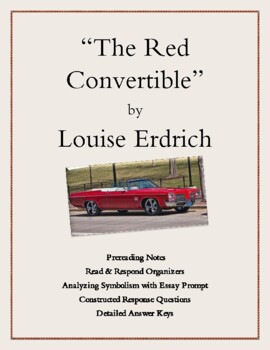"The Red Convertible" by Louise Erdrich: Notes, Close Reading, Symbol Analysis
- Zip
What educators are saying
Description
This set of guided reading and critical thinking activities for “The Red Convertible” by Louise Erdrich will help high school students actively explore this story of a Native American family and the tragic effects of a war.
The plan’s prereading notes supply knowledge of the author’s heritage, brief summary of the Vietnam War, the draft, and the effects of PTSD. Also included is a list of tone words for students to use with the response pages.
A chart directs students to respond to each sentence in the first paragraph—once as they begin the story and again with new knowledge after a close reading of the entire text.
The “read and respond” pages are divided into five major segments that closely follow the narrator’s retelling of the events. A selection of prompts and quotes will aid comprehension and provide space for students to react and analyze. These organizers also will guide students in making inferences, analyzing tone, locating foreshadowing, and noting shifting verb tense. A detailed answer key is provided for all items.
The story shows how some can physically survive a war but suffer lasting mental scars. Erdrich taps into these abstract concepts with rich use of language and symbolism. The organizer for analyzing symbolism includes two charts with prompts and a list of matching abstract words for student responses. A detailed answer key is provided. The chart can be used as a prewrite for the essay that follows with specific directions and a rubric.
A set of 10 constructed response questions can be used for assessment or closure. These questions address such elements as character analysis and key central ideas in the story. A sample answer key is included for these questions.
Contents List:
Prereading Student Notes: (PDF)
· Author’s biography
· Basic information for the Ojibwe Chippewa
· Context of the Vietnam War & Draft
· Explanation of PTSD
· List of Tone Words for use during reading
During Reading Graphic Organizers: (PDF)
· Opening paragraph: Before & After Reading
· Guided Reading Questions, Prompts, Quotes
· Detailed answer key
Post Reading:
· Analyzing Symbolism with detailed answer key (PDF)
· Essay Prompt & Rubric
· 10 Constructed Response Questions & Sample Answer Key (Word doc.)





